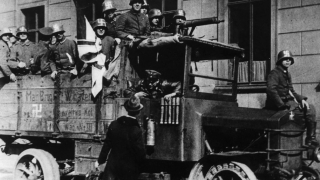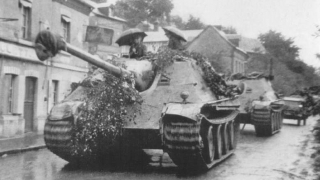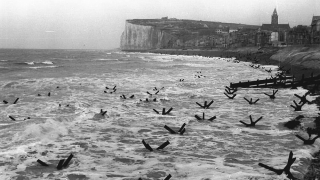75 years ago: Red Army surrounds Berlin and analysing Germany's failed 1942 advance
Three-quarters of a century ago, on 21 April 1945 the Soviet Army had encircled Berlin and was unleashing its final attack upon Nazi Germany.
With the Germans having killed more than 10 million Soviet troops since their June 1941 invasion, the last remnants of the Wehrmacht and SS were still vastly outnumbered in their defence of Berlin. Soviet ruler Joseph Stalin, on the cusp of celebrating his most important triumph, amassed around 2.5 million Red Army soldiers for this assault on the German capital, supported by over 6,000 tanks and 7,500 aircraft. (1)
For the Battle of Berlin, Stalin's old nemesis Adolf Hitler managed to gather almost a million troops, but a proportion of them had seen too many winters, or too few. The cream of German armies had either been wiped out by the Soviets over preceding month and years, or were in captivity. By 16 April 1945, the Red Army began their assault towards Berlin, with a massive artillery bombardment on the German defences along the Oder-Neisse river line.
The previous day – 15 April 1945 – Hitler, dressed in full military attire, emerged in the morning from the cramped, overcharged atmosphere of the Führerbunker. Stepping outside into the fresh spring air, he looked about at his surroundings. Everything was still and quiet, the sky clear. Hitler walked the short distance from the Führerbunker to the Reich Chancellory, and he was joined by Hans Baur, his personal pilot since early 1932. During the 1920s, Baur was one of Germany's most renowned commercial pilots, earning a variety of awards and recognition from the Weimar government.
Writing in his memoirs originally published in 1956, Baur recalled how, “Hitler had personally taken charge of the defence of the Reich Chancellory, and on 15 April [1945] – it was a beautiful sunny day – he appeared in the garden to give various instructions... A thousand men of his Leibstandarte under the command of General Mohnke were there to defend Hitler's last stronghold to the end”. (2)
With the Soviets closing in, Hitler rejected the pleas of underlings urging him to flee southwards towards Bavaria. Captain and crew would go down with the ship together. Apart from the Leibstandarte, very few remained in this area during the final days. Even SS commando Otto Skorzeny, the saviour of Benito Mussolini 18 months before and one of Hitler's favourite soldiers, had since left.
Hitler saw Skorzeny for the last time in the Reich Chancellory in late March 1945, when the Nazi leader awarded him the prestigious Oak Leaves to the Knight's Cross. Skorzeny got out of Berlin while he could. On 12 April 1945 he was present in Linz, the Austrian town where Hitler spent most of his youth and had planned to remodel. By 15 April Skorzeny moved on and “was drawing up plans for a full-scale guerrilla war should conventional methods fail to halt the Allies”, according to Skorzeny's recent biographer, English historian Stuart Smith. (3)
That same day, standing outside the Führerbunker on 15 April 1945, Hitler inspected the defences of the Reich Chancellory perimeter. He then made his way into the Reich Chancellory itself, one of the very few large buildings standing in Berlin. Suddenly appearing in the Reich Chancellory was Magda Goebbels, wife of propaganda minister Joseph Goebbels. Shocked to see her at this late date Hitler said, “For heaven's sake Frau Goebbels, what are you doing here in Berlin? You should have gone away long ago. Baur here will fly you to the Berghof whilst there's still time. You will be safe there with your children”. (4)
Magda Goebbels protested and Hitler's orders were refused, for once. Instead she saw fit to remain in Berlin to die – before killing herself, she would allow her six children to be poisoned with cyanide as they slept in their beds, drugged with morphine.
Hitler had not foreseen the catastrophe that was engulfing his empire. Only two and a half years before, he was convinced that the Russians were finished. It appeared that way to many at the time.
During the summer and early autumn of 1942, this was the period of the great German advance into far-eastern Ukraine, southern Russia and the Caucasus: principally towards the Russian cities of Stalingrad and Astrakhan, along with another drive further south to capture Baku, the capital of energy rich Azerbaijan, or so it was hoped. As Hitler knew, Baku was dripping in oil. This city provided 80% of the oil consumed by the Soviet war machine (5). Taking Baku would constitute a hammer blow to the Soviets.
Reminiscing on developments, the Nazi war minister Albert Speer acknowledged that by August 1942 “there actually no longer seemed to be any resistance to Hitler left in Europe” (6). It should be recognised that, from the summer of 1942, this German advance hundreds of miles into the western and southern Soviet Union was one of the most incredible feats in military history. During Napoleon's invasion of Russia 130 years before, he was simply unable to progress as far as this, failing to survive the winter even.
Nevertheless the Wehrmacht could not replenish the casualties they suffered from June 1941. In the first six months of their invasion of the USSR, the Germans lost more than 900,000 men, along with being shorn of 6,000 aircraft and over 3,200 panzers and other armoured vehicles. Most German troops partaking in the 1942 offensive, had been involved from the start of Operation Barbarossa the year before.
Jacques R. Pauwels, the veteran Belgian-born historian, wrote that German forces “available for a push toward the oil fields of the Caucasus were therefore extremely limited. Under those circumstances, it is quite remarkable that in 1942 the Germans managed to make it as far as they did”. (7)
The Soviet Union, with almost twice the population of Nazi-occupied Europe, was able to replace much of their losses relating to manpower. The Soviets could also count on their greater industrial strength, and the bigger quantities of raw materials at their disposal.
It can be recalled that large-scale German victories were achieved in the early summer of 1942 – before Hitler's offensive eastwards, Case Blue, had gained a head of steam in the high summer. Beginning on 12 May 1942, a huge clash unfolded in eastern Ukraine, known as the Second Battle of Kharkov. This city, Kharkov, was the Soviet Union's third largest metropolis.
At the commencement of fighting in Kharkov, which the Soviets initiated, the Germans and their Axis partners were outnumbered on the ground by more than two to one. However, during the next fortnight, the Wehrmacht inflicted over 200,000 fatalities on the Soviets, along with the capturing of up to 240,000 Red Army soldiers. By comparison, the Axis powers lost less than 30,000 men in the Second Battle of Kharkov, and the city was taken by German-led forces on 28 May 1942.
Five weeks later, on 4 July 1942, the Crimea was in German hands, after they finally eliminated (with Romanian help) Soviet resistance at Sevastopol – the Crimea's biggest city. Hitler was increasingly impatient for Sevastopol to be taken, and he had said as early as 21 August 1941 that, “the Crimean peninsula has colossal importance for protection of oil supplies from Romania” (8). Soviet bloodletting was again terrible. Since late October 1941 they had suffered over 300,000 casualties during the Battle of Sevastopol. Also on 4 July 1942, Soviet forces retreated from the cities of Kursk and Belgorod further north.
Meanwhile, the fine weather seemed as if it would last forever. On 5 July 1942, German soldiers from the 4th Panzer Army marching under a blazing sun saw water shimmering on the horizon. It was what they hoped to see. They had reached the Don River, just 200 miles west of Stalingrad (9). Ten days after, on 15 July, Soviet forces fled the towns of Boguchar and Millerovo, less than 200 miles from Stalingrad. The way appeared open to advance upon the city.
The following day, 16 July 1942, Hitler relocated hundreds of miles eastwards, settling into new surroundings near the town of Vinnitsa, in central Ukraine. His complex at Rastenburg, East Prussia, was positioned too westward and no longer deemed suitable. Hitler's headquarters beside Vinnitsa again had the word “wolf” inserted into it, and was called Führerhauptquartier (FHQ) Werwolf. The title was apt here.
Hitler's chief pilot, Baur, remembered how, “It sticks in my mind in particular as the place where I first saw wolves outside a zoo. We were taxiing towards the start with Hitler on board, when I spotted a couple of wolves at the edge of the airfield. They didn't seem much disturbed at our approach, and we got quite close to them before they finally looked at us, and then loped off into the forest. My mechanic had drawn Hitler's attention to them, and we all saw them very clearly”. (10)
As July 1942 moved on the successes continued, one after another. The German 1st Panzer Army took the city of Voroshilovgrad, in far eastern Ukraine, on 18 July 1942 – followed by the capture of Krasnodon, two days later, another city in the Ukraine's extreme eastern reaches. Virtually all of the Ukraine was now under Nazi rule.
On July 22nd, the German 6th Army reached the great bend in the Don River, as they approached ever closer to Stalingrad. Rostov-on-Don, a sizable Russian city 250 miles from Stalingrad, fell just hours afterwards to the 1st Panzer Army on July 23rd. The taking of Rostov was a significant victory, as the Wehrmacht was previously driven from this city by the Soviets in early December 1941. Older Rostov inhabitants were familiar with the sight of German troops. Rostov had also fallen to the German Army a quarter of a century before, under the leadership of Erich Ludendorff and Paul von Hindenburg.
The day after Rostov's capitulation, 24 July 1942, another major German success was secured with the conclusion of the Battle of Voronezh, near the Don River. The Soviets lost over 550,000 men during the Battle of Voronezh, while the Wehrmacht and their Hungarian allies had less than 100,000 casualties (11). This battle, lasting for almost four weeks, is little known. Yet Soviet losses during it were comfortably higher than German casualties during all of the fighting at Stalingrad. The Red Army could just about afford to sustain such disasters, while the Germans clearly could not. That same date, July 24th, the city of Novocherkassk was taken by the Wehrmacht in Rostov oblast.
There is little doubt that, overall, German troops were of much superior quality to Red Army soldiers, time and again inflicting a far higher casualty rate on the Soviets. The problem was that, in the end, there were simply not enough German soldiers in existence while, as mentioned, the Soviets could call on a vast reserve of fresh troops to fill in their horrendous casualty list.
Yet the German advance continued relentlessly. German Army Group A marched towards the Caucasus on 25 July 1942, and further victories were clocked up. On July 27th, Bataysk, a city in Rostov oblast was taken. The following day Stalin issued Order No. 227 demanding of his soldiers “Not a step back!” Unfortunately for Stalin, this unrealistic order would be disregarded and had a largely detrimental effect upon morale. There were to be lots of steps back in the days ahead.
From July 30th, the Battle of Rzhev was beginning around 150 miles west of Moscow. Over coming weeks the Soviets would suffer in excess of 300,000 casualties there, about five times as much as the Germans.
On 2 August 1942, a long column of German motorised infantry from the 4th Panzer Army stormed the town of Kotelnikovo, 110 miles south-west of Stalingrad (12). Two days later, the 4th Panzer Army crossed the Askay River in its drive on Stalingrad. A few hours after, the city of Voroshilovsk fell on August 5th. Its airport would be used by the Luftwaffe to execute bombing raids on Soviet oil routes. On August 6th, the southern Russian towns of Tikhoretsk and Armavir, 80 miles apart, were taken within hours of each other in the separate advance towards the Caucasus.
On 9 August 1942, special forces led by Waffen-SS officer Adrian von Fölkersam captured the city of Maikop without a fight, at the base of the Caucasus Mountains. In fear of a major German assault, Soviet forces were fleeing in disarray from Maikop, ignoring Stalin's order. Quickly following von Fölkersam's units in the rear, the 1st Panzer Army then occupied Maikop, but found the surrounding area had endured scorched earth tactics. It would prove difficult to exploit Maikop's famous oil reserves. On reaching Maikop the 1st Panzer Army, commanded by Field Marshal Ewald von Kleist, had advanced more than 300 miles in less than two weeks.
On 10 August 1942, the German 6th Army crossed the lower Don River. German officers, pausing for breath under the sun and looking into their binoculars, could clearly see the outer suburbs of Stalingrad before them. Having been shorn of much of their armour the month before, Hitler now expected the 6th Army to take the whole of Stalingrad by October 1942. This industrial city stretched for 25 miles along the western bank of the Volga River. (13)
Southwards, the march to the Caucasus was indeed advancing as planned. On August 15th, the German 23rd Panzer Division captured the town of Georgiyevsk, deep into south-western Russia (14). They were positioned 1,500 miles from Berlin, and within striking range of the frontiers of Georgia.
At this time, in the middle of August 1942, Speer travelled to see an elated Hitler at the FHQ Vinnitsa Werwolf, and he noticed that “The entire headquarters was in splendid humour”. Speer joined the dictator outside the latter's modest bungalow, and they sat down on a bench under trees to discuss the next steps.
Hitler explained how they would now “advance south of the Caucasus and then help the rebels in Iran and Iraq against the English. Another thrust will be directed along the Caspian Sea towards Afghanistan and India”. Addressing Speer and several industrialists the next day, Hitler expected that “by the end of 1943 we will pitch our tents in Tehran, in Baghdad, and on the Persian Gulf. Then the oil wells will at last be dry as far as the English are concerned”. (15)
Within a few months, these dreams of conquest would be shattered. Spread out across endless expanses of the western and south-western Soviet Union by the autumn of 1942, the Germans and their Axis allies were under growing strain.
Pauwels, the experienced world war historian, wrote of the Germans that “when their offensive inevitably petered out, in September of that year [1942], their weakly held lines were stretched along many hundreds of kilometres, presenting a perfect target for a Soviet counterattack. This is the context in which an entire German army was bottled up, and ultimately destroyed, in Stalingrad”. (16)
As further noted by Pauwels, the real turning point of the war in Europe did not occur at Stalingrad, but in fact took place a year before in late 1941, when the Germans failed to capture Moscow. By 1942, the Wehrmacht was irreversibly weakened, their aura of invincibility gone, in spite of all of the above victories.
Notes
1 Warfare History Network, “Doomed: How the Battle of Berlin Ended Nazi Germany for Good”, The National Interest, 7 April 2020, https://nationalinterest.org/blog/buzz/doomed-how-battle-berlin-ended-nazi-germany-good-141872
2 Hans Baur, I Was Hitler's Pilot (Frontline Books, 30 Sep. 2019), p. 174
3 Stuart Smith, Otto Skorzeny: The Devil's Disciple (Osprey Publishing, 20 Sep. 2018), p. 227
4 Baur, I Was Hitler's Pilot, p. 175
5 Georg Woodman, 2033-The Century After: How the World Would Look/Be If Nazi Germany & Empire Japan Had Won World War II (Strategic Book Publishing & Rights Agency, LLC (October 18, 2017), p. 128
6 Albert Speer, Spandau: The Secret Diaries, (Fontana, London, 1977) p. 58
7 Jacques R. Pauwels, “75 Years Ago, the Battle of Stalingrad”, Global Research, 5 February 2018, https://www.globalresearch.ca/75-years-ago-the-battle-of-stalingrad/5628316
8 C. Peter Chen, “Battle of Sevastopol”, World War II Database, January 2008, https://ww2db.com/battle_spec.php?battle_id=214
9 Donald A. Bertke, Gordon Smith, Don Kindell, World War II Sea War, Vol 6: The Allies Halt the Axis Advance (Bertke Publications; null edition May 31, 2014), p. 337
10 Baur, I Was Hitler's Pilot, pp. 134-135
11 David Glantz, Armageddon in Stalingrad, Brad DeLong's Grasping Reality, 18 November 2012, https://www.bradford-delong.com/2012/11/liveblogging-world-war-ii-november-18-1942.html
12 Jochen Hellbeck, Stalingrad: The City that Defeated the Third Reich (Public Affairs, 11 Oct. 2010)
13 Hellbeck, Stalingrad
14 Robert Forczyk, The Caucasus 1942-43: Kleist's Race for Oil (Osprey Publishing, 19 May 2015)
15 Speer, Spandau: The Secret Diaries, pp. 58-60
16 Pauwels, "75 Years Ago, The Battle of Stalingrad", Global Research, https://www.globalresearch.ca/75-years-ago-the-battle-of-stalingrad/5628316













